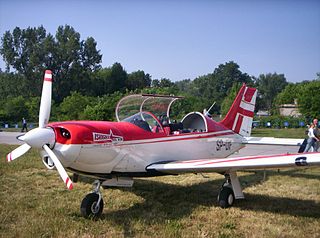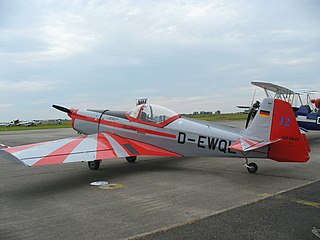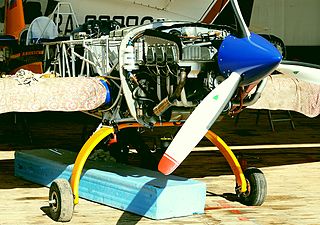
The Zivko Edge 540 manufactured by Zivko Aeronautics is a highly aerobatic aircraft. Capable of a 420 degree per second roll rate and a 3,700 foot per minute climb rate, it has been flown to victory on the international Unlimited aerobatics circuit several times since the mid-1990s. A tandem-seat version is sold as the Edge 540T.

The CAP Aviation CAP-23x family is a family of aircraft designed for competition aerobatics. The CAP 230 airframe was a direct development of the CAP 21 competition single seater strengthened to cope with a 300 hp (220 kW) 6-cylinder Lycoming AEIO-540 engine instead of the 200 hp (150 kW) original 4-cylinder Lycoming AEIO-360.

The Pitts Special is a series of light aerobatic biplanes designed by Curtis Pitts. It has accumulated many competition wins since its first flight in 1944. The Pitts biplanes dominated world aerobatic competition in the 1960s and 1970s and, even today, remain potent competition aircraft in the lower categories.

The Extra 200 is a two-seat, tandem arrangement, low-wing aerobatic monoplane with conventional (taildragger) landing gear fully capable of Unlimited category competition, built by Extra Flugzeugbau.

The Zlin Z-50 is an aerobatic sports airplane built by the Czechoslovakian company Zlin Aircraft.

The Lycoming O-540 is a family of air-cooled six-cylinder, horizontally opposed fixed-wing aircraft and helicopter engines of 541.5 cubic inches (8,874 cc) displacement, manufactured by Lycoming Engines. The engine is a six-cylinder version of the four-cylinder Lycoming O-360.

The American Champion 8KCAB Decathlon and Super Decathlon are two-seat fixed conventional gear light airplanes designed for flight training and personal use and capable of sustaining aerobatic stresses between +6g and −5g. The Decathlon entered production in the United States in 1970 as a more powerful and stronger complement to the American Champion Citabria line of aircraft.

The Grob G 120 is a two-seat training and aerobatic low-wing aircraft with a carbon composite airframe, built by Grob Aircraft. It is based on the Grob G 115TA training aircraft and is specially designed for military and civil pilots training. It has a tricycle landing gear and a low tailplane.

PZL M26 Iskierka or M26 Airwolf is a Polish trainer and aerobatic aircraft, designed at WSK PZL-Mielec.

The Zlin Z-526 Akrobat is a Czech sports plane used in aerobatics.

The AS/SA 202 Bravo is a two to three-seat civil light aircraft jointly designed and manufactured by the Swiss company Flug- und Fahrzeugwerke Altenrhein (FFA) and the Italian company Savoia-Marchetti. The aircraft was designated the AS 202 in Switzerland, and the SA 202 in Italy.

The Christen Eagle, which later became the Aviat Eagle in the mid-1990s, is an aerobatic sporting biplane aircraft that has been produced in the United States since the late 1970s.

The Extra 230 was a single-seat aerobatic aircraft developed in Germany in the early 1980s. Designed by aerobatic pilot Walter Extra based on the layout of the Laser 200 he was previously flying, the Extra 230 was a conventional mid-wing cantilever monoplane with fixed tailwheel undercarriage and a wire-braced empennage. The fuselage and empennage were of steel tube construction, but the wings were wooden. Production continued until 1990, at which time it was replaced by the Extra 300

The Lycoming IO-580 engine is a horizontally opposed, six-cylinder aircraft engine featuring three cylinders per side, manufactured by Lycoming Engines.
The Jurca MJ-51 Sperocco is a plans-built two-seat tandem aerobatic aircraft derived from the Jurca MJ-5 Sirocco.

The XtremeAir Sbach 342 (XA42) is a German high performance two-seat aerobatic and touring monoplane designed by Philipp Steinbach with Albert Mylius and built by XtremeAir GmbH of Hecklingen.

The MSW Votec 322 is a Swiss two-seat low-wing monoplane based on the Rihn DR-107 One Design and designed for amateur construction by MSW Aviation of Wohlen.
The Rihn DR-109 is an American aerobatic homebuilt aircraft that was designed by Dan Rihn. The aircraft was supplied by Jim Kimball Enterprises of Zellwood, Florida and more recently by Ashcraft Aero Works of Aurora, Illinois in the form of plans. It was designed for competition aerobatics as well as a trainer for the Rihn DR-107 One Design.

The Extra EA-260 is a hand-built, single-seat aerobatic aircraft derived from the Extra 230 and first flown in 1986. Designed by aerobatic pilot Walter Extra based on the layout of the Extra 230, the Extra 260 is a higher performance version of its predecessor with 60% more power and 18% increase in weight. The first EA-260 was flown by Patty Wagstaff to victory in two U.S. National Aerobatic Championships, in 1991 and 1992, and then retired to the Smithsonian Institution when she obtained an Extra 300S.
The Extra NG is a two-seat German aerobatic monoplane designed by Walter Extra and built by Extra Aerobatic Aircraft.






















